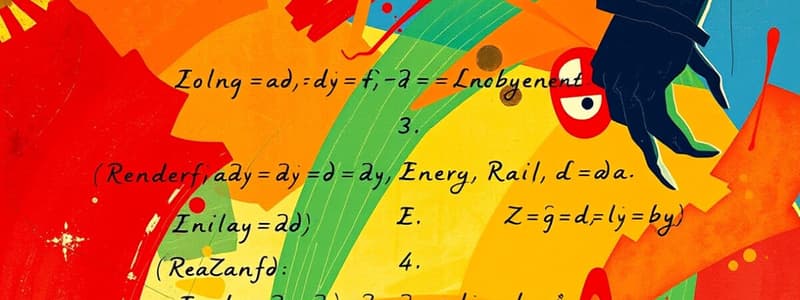Podcast
Questions and Answers
What is meant by (overregularization)?
What is meant by (overregularization)?
- Children only produce regular forms.
- Overregularization occurs when a morphological rule is correctly applied.
- All types of stems may be regular or irregular. (correct)
- An irregular stem is one that is not inflected according to the rules that normally apply to words in its grammatical category. (correct)
What occurs when morphological rules are incorrectly applied to irregular stems?
What occurs when morphological rules are incorrectly applied to irregular stems?
Overregularization
What forms do children initially not produce many of?
What forms do children initially not produce many of?
Inflected forms
What type of learning is described by children initially mastering irregular forms and then making overregularization errors?
What type of learning is described by children initially mastering irregular forms and then making overregularization errors?
What does the dual route model propose?
What does the dual route model propose?
The single route model posits that all past tense forms are stored as lexical entries.
The single route model posits that all past tense forms are stored as lexical entries.
What is the issue the dual route model faces when considering error rates?
What is the issue the dual route model faces when considering error rates?
Which criticism did Pinker and Prince have regarding Rumelhart and McClelland's model?
Which criticism did Pinker and Prince have regarding Rumelhart and McClelland's model?
What are phonological friends in the context of language acquisition?
What are phonological friends in the context of language acquisition?
Flashcards are hidden until you start studying
Study Notes
Overregularization
- Irregular stems do not follow standard grammatical inflection rules.
- Stems can be categorized as either regular or irregular.
Examples of Irregular Forms
- English has notable irregular nouns (mouse/mice), verbs (go/went/gone), and adjectives (good/better/best).
Overregularization Errors
- Occur when children incorrectly apply morphological rules to irregular forms (e.g., "goed" instead of "went").
- This phenomenon illustrates developmental patterns in language acquisition.
U-Shaped Learning
- Children initially produce few inflected forms.
- They quickly gain proficiency in frequent irregular forms (e.g., went, was).
- As they learn inflections, they may err with overregularization despite having used correct forms earlier.
- Eventually, they learn to recognize exceptions, indicating progression through U-shaped learning curves.
Dual Route Model
- Proposes two methods for producing plural and past tense inflections in English.
- First method involves retrievement of the correct form from memory, crucial for irregular forms.
- Second method applies grammatical rules for generating regular inflected forms, which children learn progressively.
Errors According to Dual Route Model
- Overregularization errors happen because fast-learning default rules compete with irregular forms, which require individual memorization.
- Children may forget a known irregular form, particularly with low-frequency verbs.
Evidence Supporting Dual Route Model
- Analysis showed that children begin making overregularization errors as they start applying the regular past tense ending.
- Errors were more common with low-frequency verbs.
Limitations of Dual Route Model
- Cross-linguistic data challenges the model's predictions about default rules.
- Observational data from various languages reveals inconsistent application of single default rules.
Issues with Default Rules
- Model assumes children globally seek one default inflection but they frequently use multiple endings for overregularization.
- Studies show children, including German-speaking ones, tend to overgeneralize various endings.
Problem with Error Rates
- Initial reports indicated low overall error rates, especially when averaged across verbs.
- Individual verbs sometimes show high error rates, contradicting the model's predictions.
Phonological Friends Issue
- The model posits that children might analogically generate irregular forms based on phonologically similar past tense forms.
- Evidence contradicts this as it doesn't explain why such errors occur more frequently with regular verbs.
Single Route Model
- Asserts all past tense forms are stored as lexical entries with retrieval prioritized for direct access.
- If retrieval fails, forms can be created through analogy, similar to phonological friends.
Evidence for Single Route Model
- Closely linked vocabulary and overregularization errors support this model.
- Key studies show children begin making errors once their verb repertoire reaches a certain level.
Computer Models in Research
- Rumelhart and McClelland demonstrated that a computer model could learn past tense forms without relying on grammatical rules.
- The model's findings are relevant, but it received both positive and negative feedback, unlike real children.
Criticism of Rumelhart and McClelland Model
- Critics argue that the model unfairly varied input during developmental stages.
- The model fails to predict minority default behaviors found in various languages.
- It struggles with homophones, highlighting a deeper complexity in language processing.
Studying That Suits You
Use AI to generate personalized quizzes and flashcards to suit your learning preferences.
